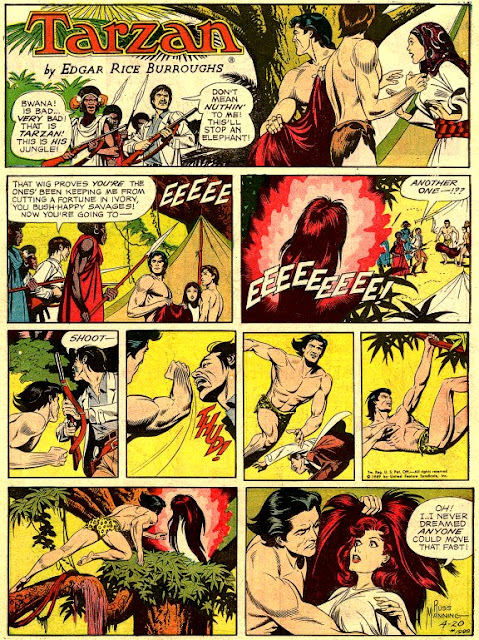Korak is the Honorable Jack Clayton, son of English Lord John Clayton, Viscount Greystoke, also known as Tarzan, lord of the jungle. He is the hero of a 1915/6 magazine serial and 1917 novel by American writer Edgar Rice Burroughs and a 1920 silent movie serial, as well as a character in several other Tarzan stories from 1914 to 1924. He experienced a revival in 1964 as the star of his own comic book series and as a major character in various Tarzan comic books, pages, and strips from 1966 to 1978.
As depicted in the comic books, pages, and strips, Korak has a lean, athletic physique, broad shoulders and thin waist, almost no clothing, a cute, boyish face, and full, thick hair. He is also an intelligent, enthusiastic teen-aged boy with excellent natural instincts and a good heart.
Korak strives to emulate his legendary father but lacks his strength, maturity and experience. Therefore, he is both more likely to enter into dangerous situations and more vulnerable to being defeated.
As the star of his own comic book series in 1964, Korak is a capable, young hero. His adventures were somewhat similar to those of his father Tarzan, but independent from them.
In 1966, ABC released the TV series Batman, featuring the frequently imperiled youthful sidekick Robin the Boy Wonder. As a fan of seeing cute, young sidekicks in trouble, I watched every episode.
Russ Manning took over the Sunday Tarzan pages in 1968. His Korak tended to have a tall, lean, swimmer's build. While the son of Tarzan continued to have somewhat autonomous adventures, the slender, handsome youth seemed to be getting into trouble more frequently and more easily. Moreover, in the Sunday Tarzan pages, Korak tended to suffer from more frequent comparisons to his legendary father.
Previous to this week's adventures, while searching for his father at the edge of the jungle, Korak follows a herd of elephants into a hidden cleft where he discovers a mystery involving a glowing, red wig. Later, after rescuing a trapped elephant, the son of Tarzan is ambushed, knocked unconscious, tied and taken to the ivory poacher's camp, where he is left bound and helpless in a supply tent. After catching up with his son and making sure that he is safe, Tarzan follows the ivory poacher and discovers the glowing, red wig, which starts an elephant stampede towards the camp. Tarzan races back to the ivory poacher's camp to rescue his son from the elephant stampede but finds that the glowing, red wig, which started the stampede, has also stopped it.
This week, Tarzan and Korak follow the glowing, red wig but get caught by the ivory poacher with his gun.
Korak remains in a supporting role this week. After being rescued by his father from the supply tent, our young hero is tackled by the girl in the red wig before all three are held at gunpoint by the ivory poacher.
This page has some good artwork of Korak by the wonderful artist Russ Manning.
Favorite scene: Panel E
This blog is intended to raise interest in and appreciation of the Edgar Rice Burroughs character Korak. To see this story in context, you may find it in Hillman's ERBzine at the following link:
This week's adventures can also be found at the following link(s):
https://www.erbzine.com/manning/690413v8.jpg









